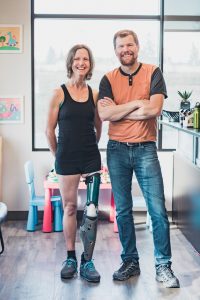Well, blog, I’ve been neglecting you.
Calling this post ‘What A Difference A Leg Makes’ would be faster, but it would spoil the suspense. Oops…
It has taken time to find energy to write about a process I have found so taxing. It has been three years of doubt and pain. And since getting back from Calgary I’ve been keen to get back to the more enticing parts of life and take a break from the anxiety caused by uncertainty regarding my mobility. Although the stress was most acute in the six months leading up to my departure, it had probably been creeping up on me for years. So now I feel weary and uninterested when it comes to thinking about the mechanical aspects of bipedal life. And a bit tired about writing about it, too. There have been cliffs to climb. Waves to catch. Celebrations to attend. And, no surprise, a great deal of work to catch up on.
My last post takes us up to mid-September, when I travelled to Calgary as planned, hoping to fall back on the builder of the last legs that worked for me. Jon’s timeline was remarkably optimistic – he was thinking to send me home in two weeks. I, on the other hand, was gunning for any period of less than four weeks. The process ended up taking 18 business days. And yes, now I have a leg that fits better than anything I have had in over three years.
I landed in Calgary on a Sunday morning. Jon took a cast of LF that afternoon. Poor LF, after 15 plus hours of flying she had earned the designation LEF, little elephant foot. I was on a trial leg in three days, the first of four versions we went through. When I left for Australia again, I took home the fourth trial leg to surf on and a final ‘finished’ version for everything else. I will longer-term test this one to ensure all the kinks are worked out. Then Jon can build a final surfing version. Importantly, he worked out a way to essentially replicate the final version of my socket from a cast of LF, as well as the upper section of the leg, which is always the first bit to wear out. Genius. Pure genius.
It was a long 18 days – I think for Jon more than me, perhaps. There were numerous long days into evenings in the shop. Many cases of two steps forward and one step back. But we got there.
I would like to say that it’s all rainbows and butterflies in the world of LF. My joint has definitely improved and I’m more comfortable in the socket than I have been in a long time… Yet there are still uncomfortable areas of pressure. The swelling has improved but persists, which comes as no surprise given it’s been present for over two years now. Because the swelling changes throughout the day, so does the fit of my leg, which means getting it to fit just right is like chasing a moving target. I’m in the process of making some adjustments, but I am wary of making any dramatic changes because what I have is by far the most functional prosthetic I have had in years. I don’t want to make the swelling worse or make a change that can’t be reversed.
Being at a distance from Jon is a challenge, but technology makes more possible than I imagined. We recently spent a couple of hours on Skype working through some of the nitty gritty details, including modifying the fit of the socket. I would send photos, he would annotate them and send them back. He was able to look at my alignment and describe for me any adjustments to make. So, I’m confident we can make most things work with me being in Australia and he in Canada, requiring only the occasional trip to Calgary for a new cast.
I am weary of the process, but I am simultaneously awash with gratitude for Jon and his efforts, as well as the time his wife and children sacrificed so that he could get me sorted. He is everything one could ask for in a clinician – highly skilled, diligent, thoughtful, humble, attentive, and reassuring. His attention to detail and cautious approach were critical to the success of my visit. He leaves me feeling heard – even with my sample size of one we share a dialogue as opposed to a dictation. He has given me back my mobility, for which I am profoundly grateful and indebted.

 ©
© 


